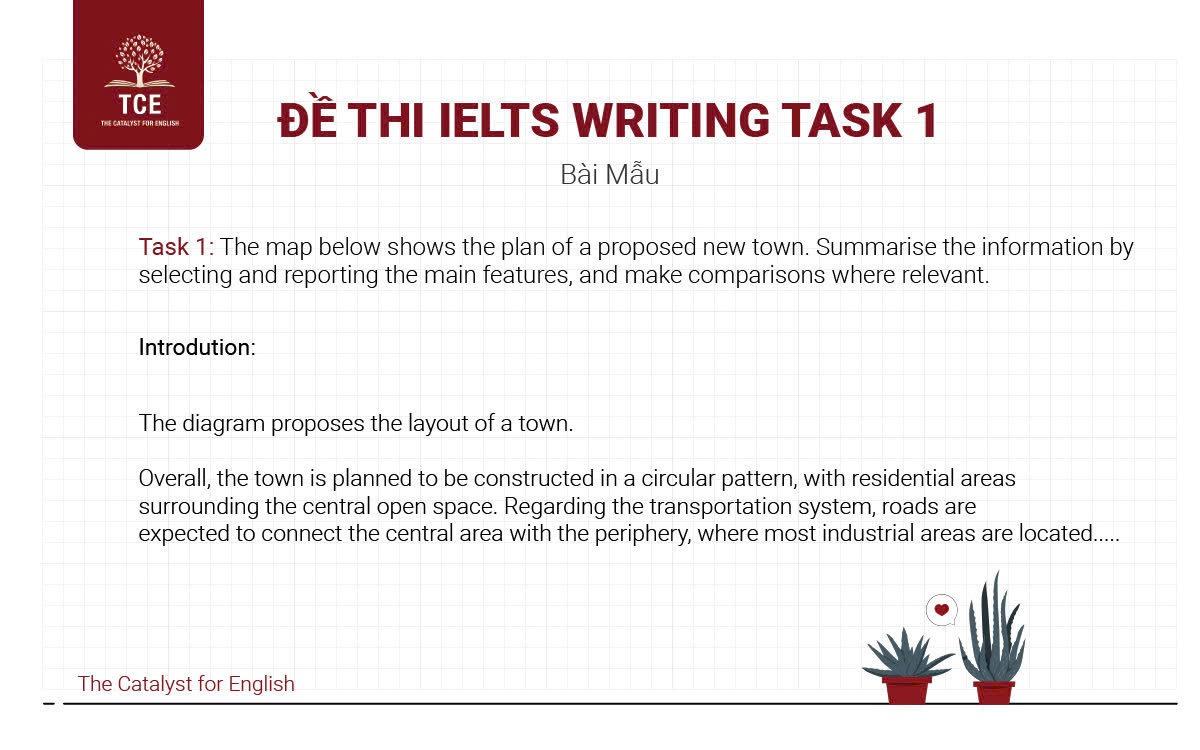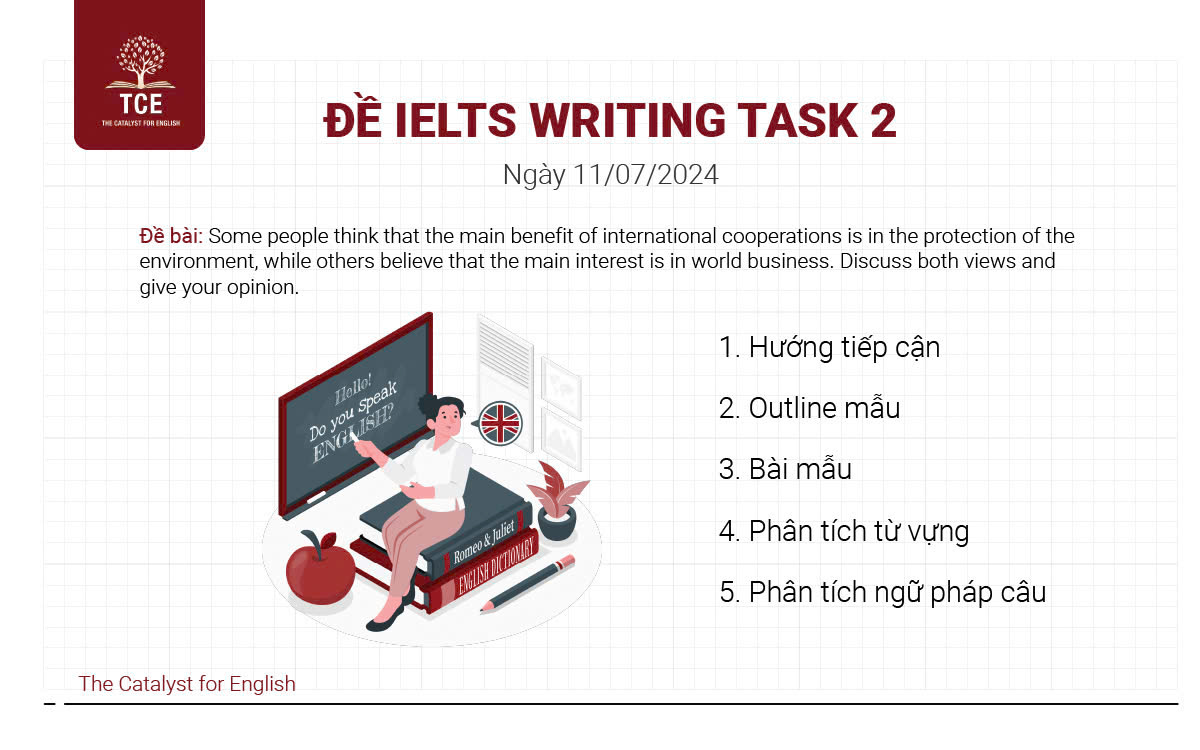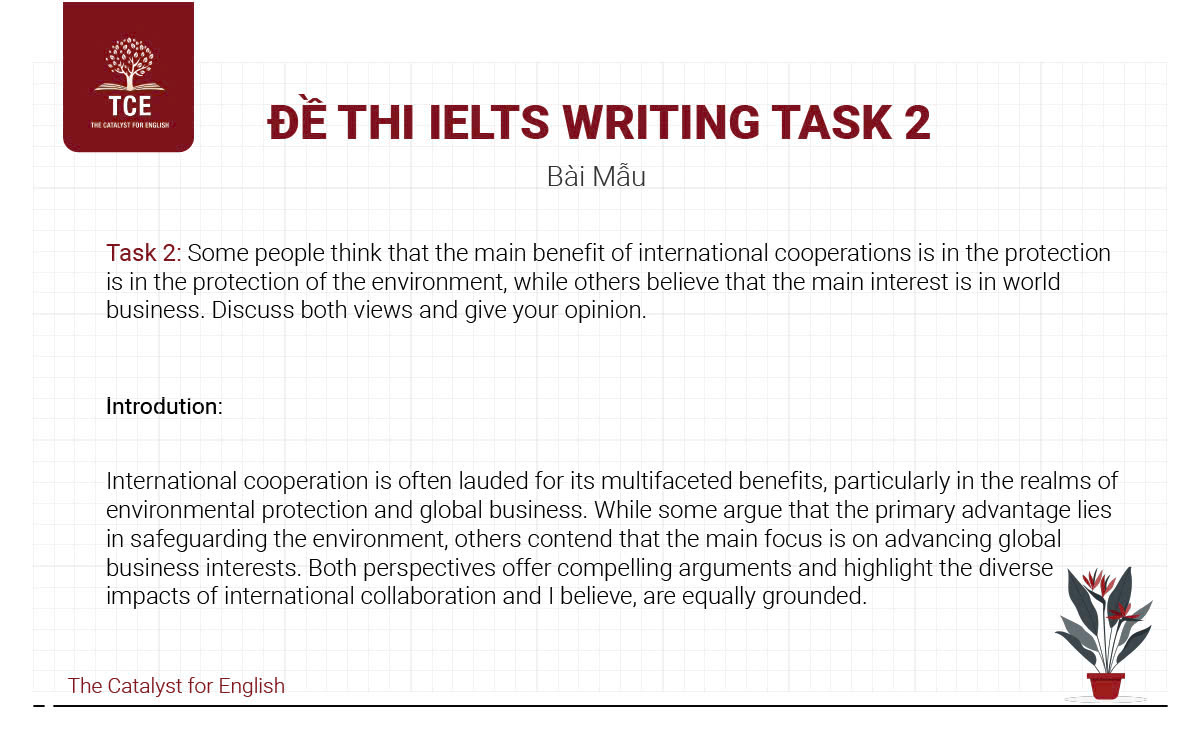[PDF + Audio] Download IELTS Simulation Test miễn phí
IELTS Simulation Test là bộ tài liệu luyện đề được săn đón hàng đầu tại Việt Nam, đặc biệt phù hợp với những bạn đặt mục tiêu Band 5.0 trở lên. Trong bài viết này, TCE sẽ mang đến cho...

Để đạt điểm cao trong phần IELTS Writing, không chỉ cần có khả năng diễn đạt ý tưởng mà còn phải biết cách phân tích và giải quyết đề thi một cách hợp lý. Việc làm quen với các đề thi thực tế là một cách tuyệt vời để luyện tập. Trong bài viết này, chúng ta sẽ giải đề thi IELTS Writing Task 1 và 2 ngày 11/07/2024, phân tích yêu cầu của từng câu hỏi và đưa ra các chiến lược viết bài hiệu quả, giúp bạn đạt được kết quả tốt nhất nhé.

Đề IELTS Writing Task 1 ngày 11/07/2024
Đề bài: The map below shows the plan of a proposed new town. Summarise the information by selecting and reporting the main features, and make comparisons where relevant.
| Nội dung | Phân tích chi tiết |
| Dạng bài | Dạng Map – bản đồ mô tả kế hoạch phát triển thị trấn mới (không phải thay đổi theo thời gian). |
| Từ khóa đề bài |
|
| Yêu cầu đề |
|
| Các lỗi thường gặp |
|
| Hướng tiếp cận từng bước |
|
| Phần | Nội dung |
| Introduction |
|
| Overview |
|
| Body 1: Khu công nghiệp |
|
| Body 2: Khu dân cư + Giải trí + Giao thông |
|

Bài mẫu IELTS Writing Task 1 dạng Map
Overall, the town is planned to be constructed in a circular pattern, with residential areas surrounding the central open space. Regarding the transportation system, roads are expected to connect the central area with the periphery, where most industrial areas are located.
Industrial zones are expected to be built separately from residential areas and recreational areas on the outskirts. The town’s major industrial zone will be located in the South East while a smaller industrial area is anticipated to develop in the Northwest.
Moving inward, entertainment areas will be established along the roads connecting the central areas and outlying areas, presumably to allow easy access to the town’s leisure opportunities. Only one space will be established in the east of the layout, with the majority of these amenities located in the southern core area. The rest of the town is planned to accommodate the residents. Specifically, its various housing areas will form a ring around the central part, where transportation hubs will be formed with bus stands and parking lots.
| Từ vựng | Phát âm | Nghĩa | Ví dụ trong câu |
| Proposed | /prəˈpoʊzd/ | Được đề xuất | “The diagram proposes the layout of a town.” |
| Layout | /ˈleɪaʊt/ | Bố trí, sơ đồ | “The diagram proposes the layout of a town.” |
| Planned | /plænd/ | Dự định, dự kiến | “The town is planned to be constructed in a circular pattern.” |
| Residential areas | /ˌrɛzɪˈdɛnʃəl/ | Khu dân cư | “The town is planned to have residential areas surrounding the central open space.” |
| Transportation system | /ˌtrænspɔːˈteɪʃən/ | Hệ thống giao thông | “Regarding the transportation system, roads are expected to connect the central area.” |
| Periphery | /pəˈrɪfəri/ | Vùng ngoại ô | “The central area with the periphery where most industrial areas are located.” |
| Anticipated | /ænˈtɪsɪpeɪtɪd/ | Dự đoán, kỳ vọng | “A smaller industrial area is anticipated to develop in the Northwest.” |
| Amenities | /əˈmɛnɪtiz/ | Tiện nghi, cơ sở vật chất | “The majority of these amenities located in the southern core area.” |
| Accommodate | /əˈkɑːmədeɪt/ | Cung cấp chỗ ở, chứa đựng | “The rest of the town is planned to accommodate the residents.” |
| Hub | /hʌb/ | Trung tâm | “Transportation hubs will be formed with bus stands and parking lots.” |
| Câu | Phân tích ngữ pháp |
| “The diagram proposes the layout of a town.” | Câu này sử dụng hiện tại đơn để miêu tả một sự kiện chung, diễn ra trong thời gian dài (mô tả bản đồ). |
| “The town is planned to be constructed in a circular pattern.” | Passive voice (bị động): “is planned” là thì bị động dùng để nhấn mạnh kế hoạch xây dựng (mà không cần chỉ rõ ai là người thực hiện). |
| “Regarding the transportation system, roads are expected to connect the central area with the periphery.” | Passive voice: “are expected” – chủ thể không rõ ràng, hành động quan trọng hơn. |
| “Industrial zones are expected to be built separately from residential areas.” | Passive voice + to infinitive: Dự đoán một hành động sẽ xảy ra trong tương lai. |
| “Moving inward, entertainment areas will be established along the roads.” | Future simple: “will be established” thể hiện một sự kiện trong tương lai. |

Đề IELTS Writing Task 2 ngày 11/07/2024
Đề bài: Some people think that the main benefit of international cooperations is in the protection of the environment, while others believe that the main interest is in world business. Discuss both views and give your opinion.
| Nội dung | Phân tích chi tiết |
| Dạng bài | Discussion Essay + Opinion: Thảo luận cả 2 quan điểm, rồi nêu rõ quan điểm của mình. |
| Từ khóa đề bài |
|
| Yêu cầu đề |
|
| Các lỗi thường gặp |
|
| Hướng tiếp cận từng bước |
|
| Phần | Nội dung |
| Introduction |
|
| Body 1: Quan điểm 1 (Environmental Protection) |
|
| Body 2: Quan điểm 2 (World Business) |
|
| Conclusion |
|

Bài mẫu IELTS Writing Task 2
International cooperation is often lauded for its multifaceted benefits, particularly in the realms of environmental protection and global business. While some argue that the primary advantage lies in safeguarding the environment, others contend that the main focus is on advancing global business interests. Both perspectives offer compelling arguments and highlight the diverse impacts of international collaboration and I believe, are equally grounded.
On the one hand, proponents of environmental protection emphasize that environmental challenges require collective action. Such environmental issues as climate change, deforestation, and ocean pollution nowadays are so intense that they require much financial and human resource investment, which transcend personal responsibility and capacity. This necessitates joint efforts for effective resolution from the masses. For instance, international agreements like the Paris Agreement facilitate collaborative climate action by setting unified targets for carbon emissions reductions. Such cooperation enables nations to pool resources, share expertise, and implement large-scale solutions that individual countries may struggle to achieve alone.
On the other hand, those who view international cooperation primarily through the lens of business argue that economic growth and market expansion are the foremost benefits. In the present world of integration, trade agreements and economic partnerships can drive global commerce, opening new markets and reducing trade barriers. Organizations like the World Trade Organization (WTO) play a crucial role in promoting economic stability by resolving trade disputes and fostering an environment conducive to international business. This can lead to increased investment opportunities, economic prosperity and in turn, help mitigate poverty, improve living standard, which are the ultimate goals of each nation.
In conclusion, while international cooperation indeed serves both environmental and business interests, I believe these goals are not mutually exclusive. The integration of sustainable practices within global business strategies reflects a growing awareness of the need for environmental stewardship. Thus, the most beneficial approach is one that harmonizes economic and environmental objectives, ensuring that global progress is achieved in a manner that is both economically viable and environmentally sustainable.
| Từ vựng | Phát âm | Nghĩa | Ví dụ trong câu |
| Lauded | /lɔːdɪd/ | Tán dương, khen ngợi | “International cooperation is often lauded for its multifaceted benefits.” |
| Multifaceted | /ˌmʌltɪˈfæsɪtɪd/ | Đa chiều, nhiều mặt | “International cooperation is often lauded for its multifaceted benefits.” |
| Safeguarding | /ˈseɪfɡɑːrdɪŋ/ | Bảo vệ | “The primary advantage lies in safeguarding the environment.” |
| Transcend | /trænˈsɛnd/ | Vượt qua | “Such environmental issues require much financial and human resource investment, which transcend personal responsibility.” |
| Collaborative | /kəˈlæbəreɪtɪv/ | Mang tính hợp tác | “International agreements like the Paris Agreement facilitate collaborative climate action.” |
| Pool resources | /puːl/ | Kết hợp tài nguyên | “Such cooperation enables nations to pool resources, share expertise.” |
| Mitigate | /ˈmɪtɪɡeɪt/ | Giảm thiểu | “This can lead to increased investment opportunities, economic prosperity, and in turn, help mitigate poverty.” |
| Prosperity | /prɒˈspɛrɪti/ | Sự thịnh vượng | “This can lead to increased investment opportunities, economic prosperity.” |
| Stewardship | /ˈstjuːərdʃɪp/ | Quản lý tài sản (nhất là về môi trường) | “The integration of sustainable practices reflects a growing awareness of the need for environmental stewardship.” |
| Câu | Phân tích ngữ pháp |
| “The diagram proposes the layout of a town.” | Câu này sử dụng hiện tại đơn để miêu tả một sự kiện chung, diễn ra trong thời gian dài (mô tả bản đồ). |
| “The town is planned to be constructed in a circular pattern.” | Passive voice (bị động): “is planned” là thì bị động dùng để nhấn mạnh kế hoạch xây dựng (mà không cần chỉ rõ ai là người thực hiện). |
| “Regarding the transportation system, roads are expected to connect the central area with the periphery.” | Passive voice: “are expected” – chủ thể không rõ ràng, hành động quan trọng hơn. |
| “Industrial zones are expected to be built separately from residential areas.” | Passive voice + to infinitive: Dự đoán một hành động sẽ xảy ra trong tương lai. |
| “Moving inward, entertainment areas will be established along the roads.” | Future simple: “will be established” thể hiện một sự kiện trong tương lai. |
Qua việc phân tích và giải đề thi IELTS Writing ngày 11/07/2024, bạn đã có thêm những kiến thức quý báu về cách làm bài hiệu quả. Bài mẫu chi tiết giúp bạn hiểu rõ hơn về các yêu cầu và cách triển khai ý tưởng trong bài viết. Để đạt điểm cao trong phần Writing, hãy tiếp tục luyện tập và áp dụng những chiến lược đã học để nâng cao khả năng viết của mình.